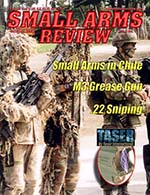SITREP: October2002
By Dan Shea
The fighting in Afghanistan continues as of this writing. I am presently in the UK, listening to the BBC as they interview British soldiers about their SA80A2 rifles. The gents don’t like them very much at present, saying that the SA80A2s have troubles just like the SA80A1 system did. The government officials are now blaming this on- the soldiers themselves. The problem turns out to be that these soldiers are not cleaning their weapons “Precisely as instructed” by the weapon manuals. Surprise, surprise. Can you imagine a system that has such a weakness that if the grunt in the bush doesn’t clean it “Precisely as instructed” it doesn’t operate? Shades of the Sixties. I will resist going on a rant here, because it would be counterproductive, but here are two items of note.
First, weapon designers need to spend time in the bush. This should be a requirement. I mean, out in nowhere, dealing with sand, jungle, dust, ice, sleeping on the ground, not having support and supplies, and being scared witless at assorted points during the day and night. They should have to cross leech-infested rivers, fall off of rock walls, and be rained on. After they have tried to clean their designs “Precisely as instructed”, and they have to field improvise cleaning systems because there are no supplies, or not have time to clean them and just have to keep shooting because they aren’t given the luxury of any time off to do cleaning, if the designs work, well, maybe our armies should adopt them.
Second, keep it simple. The key to success with most small arms is two-fold; robust construction, and economy of design. Don’t overcomplicate it. Many times designs are born, then when flaws are discovered, the fixes are started. These fixes take on a life of their own, many times complicating not only the system, but the troubleshooting of that system’s flaws. The M16 series is a prime example.
I truly like the M16. Gene Stoner once explained that the system had been designed in a certain way, with a certain ammunition, with certain features. As soon as any of the variables are significantly changed, a system will need “Fixes”. Example: The M16 as designed was an amazing, reliable weapon, with devastating, yes, devastating terminal effects. The men who fired it in combat said the effects on the Viet Cong were “Devastating”. Enter an ammunition contract where the powder is changed, and 100 million rounds manufactured in the new, untested style. The men go to combat, and the weapons seize up. The men get blamed for “not cleaning properly”.
Lots of good men died over that one, and there are a lot of GIs who have a resentment about that even today. Soldiers don’t forget. The solutions came from many directions, and each brought its own further complications. Shortening barrels, changing weights, changing materials, all had their own odd effects, until today, with the M4 carbine, we have an amazing system that has a few flaws that were not evident to the original design.
Yet, the various British special forces have chosen the M4 Carbine over the SA80A2 to go into combat. That says something, and it is not complimentary to the SA80A2 as it exists.
HK puts their weapons systems through rigorous testing, as noted in previous editions of SAR where we accompanied them on torture testing in the desert. HK Oberndorf did the upgrade to the SA80A1 system to the A2 configuration, and they are well known for how thorough they are.
This old soldier hopes that they are looking closely at the design, to discover what is still in need of correction on the SA80 system, so that the British officials can’t stand there and blame the incorrect cleaning of the weapon system by soldiers for the failures. HK engineers can certainly solve this problem if given reign to do so. The irony of the Germans fixing the British rifles is not lost on us either, and the reason that American companies couldn’t bid on this $150 million upgrade project is precisely due to the ridiculous regulations we in the US have to attend to for importation for manufacturer’s purposes. I can think of two members of the SAR community that not only have the engineering know-how and equipment to undertake at least bidding on the SA80 upgrade project, but they have the financial ability as well. There are others, and America lost an opportunity for business due to these fine companies’ inability to get Form 6 imports on SA80s for testing purposes.
SAR will be looking in depth at the system, starting with the EM1 and EM2, and on into the L85A1 and L86A1 variants in the SA80s. We promise to dig as deep as we can into this interesting and potentially very viable system.
-Dan
This article first appeared in Small Arms Review V6N1 (October 2002) |
| SUBSCRIBER COMMENT AREA |
Comments have not been generated for this article.



